LOWER BEAK
We examined four beaks of Mg. magna from individuals (135, 141, 150, 160 mm ML). The following characters are taken from Clarke (1986). Arithmetic means, based on the four squid are used for characters requiring measurements.
- Pigmentation - Light side of normal.
- Pigmentation pattern - No beaks were examined from squid less than 135 mm ML. At this size, the beak is fully pigmented except for the aboral side of the wing opposite the shoulder.
- (Wing length)/(visible rostral edge) (profile) - 1.85
- Height/baseline (profile) - 0.86
- (Length from rostral tip to wing tip projected on baseline)/baseline (profile) - 0.27
- (Hood length)/(crest length) (profile) - 0.51
- (Crest length)/baseline (profile) - 0.64
- (Rostral base)/(visible rostral edge) (profile) - 1.05
- (Hood length)/(visible rostral edge) (profile) - 0.85
- Rostral width ratio [LRL/(length between jaw angles)] - 1.47
- Wing angle (= visible jaw angle in profile) - Obtuse.
- Shape of jaw edge - Almost straight but with small, gradual hook.
- Rostrum (profile) - Broad taper to tip.
- Hood distance from crest - Close to crest.
- Crest - Nearly straight.
- Lateral wall notch - Virtually absent.
- Hood-wing - Broad.
- Hood notch - Broad to narrow.
- Lateral walls to free corner - Broadly separated with increasing but low divergence from one another.
- Hood midline - Moderately curved.
- Hood surface without prominent longitudinal ridges or grooves.
- Wing fold - Low, rounded, obscures jaw angle in profile.
- Shoulder - Shoulder blades well developed in one beak (141 mm ML) but are only stubby remnants in another (135 mm ML). In the former, the shoulder blade is large and trapezoidal with oral ends projecting very slightly.
- Shoulder groove - Absent to moderate.
- Jaw angle - Slightly obtuse, without associated step or transparent strip.
- Jaw edge extension - Extends well beyond shoulder padding and terminates in a sharp or blunt angle point well short of lateral wall edge.
- Terminal shoulder filling pigmentation - Sharply defined; final stage a thin, unpigmented line adjacent to lateral wall and extending to aboral edge of padding at posterior padding apex.
- Jaw edge in cross-section - Sharp.
- Crest in cross-section - Somewhat broad.
- Lateral wall - Low, broad lateral-wall fold extends to posterior edge of lateral wall; broad medial groove matches lateral fold; fold slightly thickened. Fold barely noticeable at first glance.

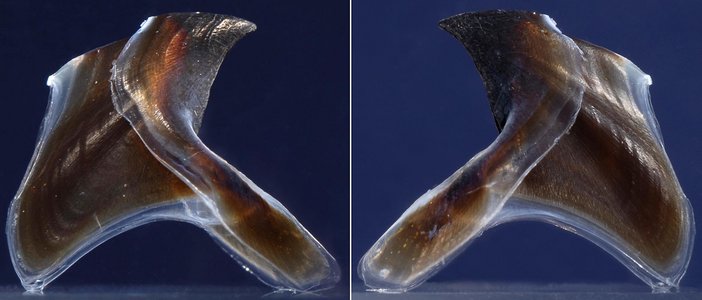
Figure. Left and right side views of the same lower beak of Mg. magna, 160 mm ML, 4.2 mm LRL, immature male, Northwest Atlantic, 40°N, 67°W. Photographs by R. Young.

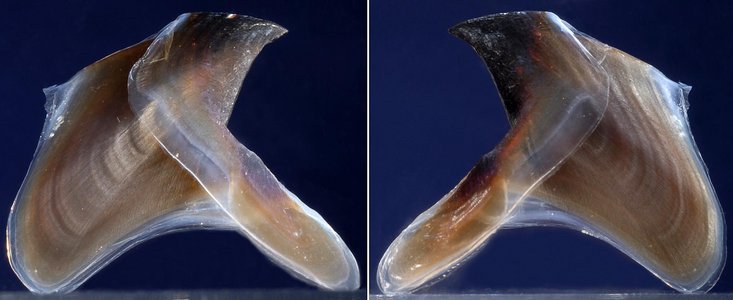
Figure. Left and right side views of the same lower beak of Mg. magna, 135 mm ML, 4.4 mm LRL, sex unknown, Northwest Atlantic. Photographs by R. Young.

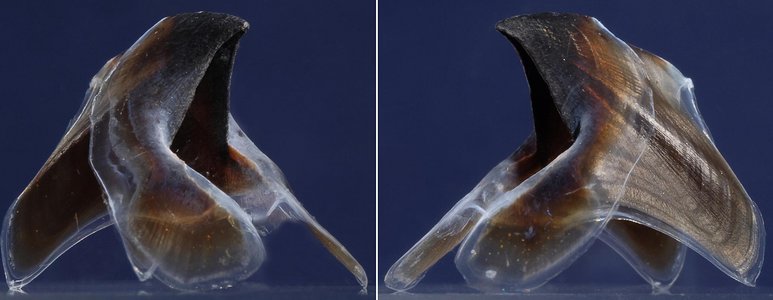
Figure. Left and right side-oblique views of the same lower beak of Mg. magna, 160 mm ML, immature male, Northwest Atlantic, 40°N, 67°W. Photographs by R. Young.

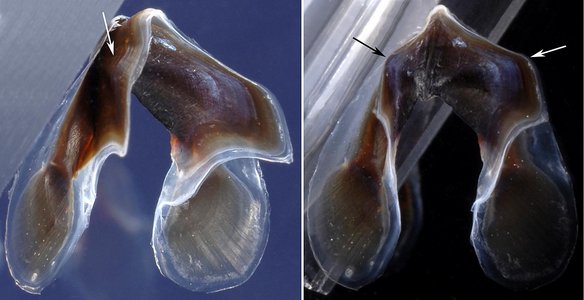
Figure. Posterior oblique (left) and posterior (right) views of the same lower beak of Mg. magna, 160 mm ML, immature male, Northwest Atlantic, 40°N, 67°W. Arrows point to the lateral wall fold. Photographs by R. Young.

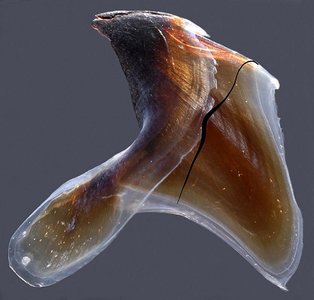
Figure. Side view of the lower beak of Mg. magna, 160 mm ML, immature male, that has been cut in half and laid flat with a drawn cross-sections of the lateral wall overlayed where the cut occurred. The rostrum broke when cutting the beak in half. Photograph by R. Young.

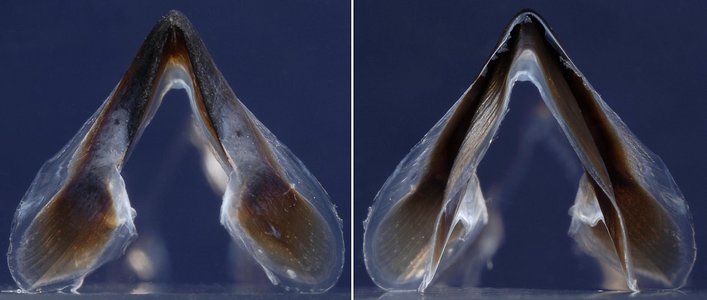
Figure. Front (left) and rear (right) views of the same lower beak of Mg. magna, 160 mm ML, immature male, Northwest Atlantic, 40°N, 67°W. Photographs by R. Young.

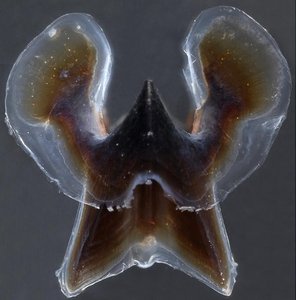
Figure. Two views of the lower beak of Mg. magna, 160 mm ML, immature male, Northwest Atlantic, 40°N, 67°W. Left - Top view. Right - Posterior-oblique view showing the width of the lateral wall ridge (arrow). Photographs by R. Young.
Comments
Mg. magna is easly separated from its closest relative among broad-beaked mastigoteuthids (ie, Mg. microlucens) by the presence of a low lateral-wall fold (absent is Mg. microlucens) that may be slightly thickened but lacks a solid ridge (distinct ridge pressent in Mg. microlucens). The fold extends to the posterior margin whose shape is modified by it. In contrast no modification occurs at this point in Mg. microlucens.
UPPER BEAK

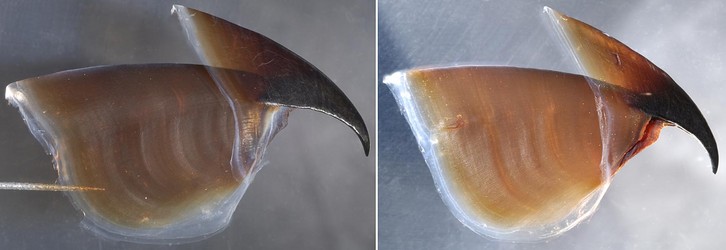
Figure. Side views of the upper beak of Mg. magna. Left - 160 mm ML, immature male, Northwest Atlantic, 40°N, 67°W. Right - 135 mm ML, sex unknown, Northwest Atlantic. Photographs by R. Young.

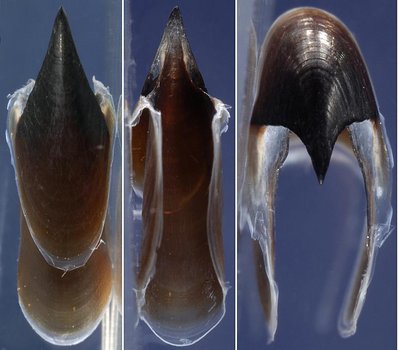
Figure. Various views of the upper beak of Mg. magna sp. A, 160 mm ML, immature male, Northwest Atlantic, 40°N, 67°W. Left - Top view. Middle - Bottom view. Right - Front view. Photographs by R. Young.
Comments
To be added.




 Go to quick links
Go to quick search
Go to navigation for this section of the ToL site
Go to detailed links for the ToL site
Go to quick links
Go to quick search
Go to navigation for this section of the ToL site
Go to detailed links for the ToL site